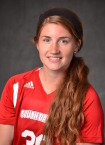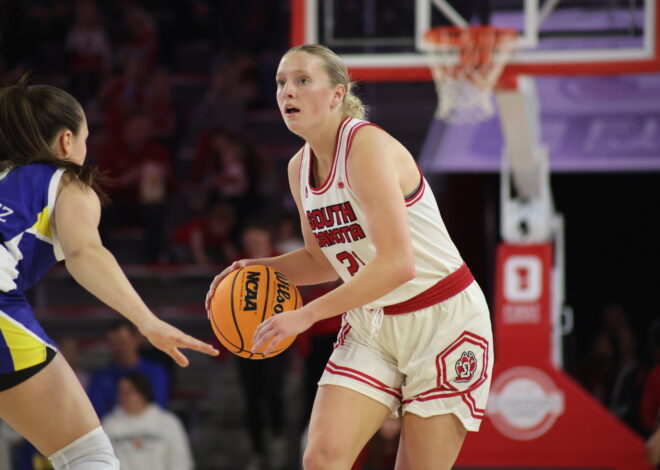
On-season, offseason athletes share regimen to compete
Fans cheer for them in the stands. Fellow students see them walking from class to class in any form of weather. But the life of a student athlete is one that suggests rigid structure and fine-tuned scheduling elusive to many people. Here are three athletes at the University of South Dakota who show what their life is like in season and off.
Junior midfielder

About the athlete: Once a standout defensive player from Edina High School in Minnesota, Tsakakis is as much a competitor in the classroom as she is on the field. In the 2014 season, the junior earned Academic All-Summit League honors and was named to the Summit League Honor Roll while earning the Distinguished Scholar status.
Her in-season regimen: The women’s soccer team schedules games on Fridays and Sundays during its fall season. There is no practice on Mondays, but Tuesdays compensate for the lack of play with a two-hour practice with an emphasis on running and conditioning. Practice continues Wednesday and Thursday, but Thursday is a lighter practice in preparation for impending matches. Teammates are expected to make each practice while in-season. Depending on the week, the team might be on a bus traveling to an away game on a Thursday or Friday. Tsakakis said the travel element leads to a struggle to make up tests and quizzes as a biology major.
Offseason schedule: Soccer players at USD become early risers in the offseason. The team practices Monday through Friday from 6-8 a.m. They also run and lift weights together on Monday, Wednesday and Friday from 4-5:30 p.m. The offseason does not mean slowing down their workout regiment, Tsakakis said. That includes spring scrimmages. But there is more accommodation to changing around a player’s schedule for more activities off the soccer field. For Tsakakis, that means being able to take upper level biology courses that would have otherwise conflicted with practice times in the fall.
Misc.: The junior said she has more time to herself in the spring with less traveling and fewer missed classes, but one upside to the long bus rides was having a place and time to do homework. “If you are stuck on a bus, it kind of forces you to actually get something done,” she said. “I might have more free time in the spring, but the fall gives me a schedule to follow every day.”
[blockquote author=”I had to get used to meeting with professors a lot more one-on-one, because when the season starts, your life revolves around soccer.” ][/blockquote]
Lukas Bernard
Senior sprinter and hurdler
About the athlete: Bernard’s final year on the track and field team recently included achieving a career best in the 400-meter hurdles. Last season, he earned All-League honors at both indoor and outdoor championships, and he posted two second-place finishes at the Summit League Outdoor Championships. Bernard was also named to the Summit League honor roll and was named to the Summit League Commissioner’s List of Academic Excellence.
In-season regimen: The hurdler and sprinter’s week leading up to a competition changes depending on the location of the track meet. Bernard said his separate preparations are ones for “big travel meets” and ones for relative home meets. In preparing for his first two meets to Arizona and Texas, the senior had a “hard practice” on the Monday and Tuesday before he left, while the travel to the three-day competition meant packing his bags by Wednesday. Following a meet at the University of Nebraska-Lincoln this weekend, Bernard’s schedule could resemble that of most track and field athletes who have Monday and Thursday off, a hard practice on Tuesday and Wednesday and Friday as a freebie to work on personal development. Typical weeks for the senior include practicing between classes, while most track practices start at two.
Offseason schedule: The first week of September leads upperclassmen back to track and field practice. “That is just practice every day at two o’clock,” Bernard said. Mondays, Wednesdays and Fridays are reserved for more difficult training, while Tuesdays and Thursdays are more targeted at recovery. The senior describes his fall semester as “pretty relaxed” with the lack of travel and practices on weekends.
Misc.: Bernard is competing in his last season of track at USD before continuing on for a yearlong experience of student teaching in Yankton. The elementary education major said while he chooses not to do homework during meets to take a breather from the grind of college, he knows of other student athletes of certain majors who have to split their time between the competition and their grades. The difference, he said, is noticeable between indoor and outdoor track season, as indoor becomes less of a distraction to homework with fewer hours of travel.
[blockquote author=”It is definitely a heavier load for outdoor.” ][/blockquote]
Keyen Lage
Junior linebacker
About the athlete: Junior Keyen Lage’s career at USD is a collection of individual achievement. He was one of two true first-years who lettered in 2012 and won USD’s Harry Gamage Most Valuable Freshman award. In 2013, he was one of 10 Coyotes who started all 12 games and also won the Tim Mojzik Bulldog Award after being selected by his teammates. His work in the 2014 season earned him the Joe Salem Defensive Player of the Year. He started all 12 games at outside linebacker and finished with 66 tackles, the fourth-highest tally on the team. Lage, who hails from Sioux Falls, had 5.5 tackles-for-loss, five pass breakups and one forced fumble.
In-season regimen: Lage is one to admit he enjoys being on a schedule. And to be on USD’s football team, the schedule he follows while in season could be seen as a full-time occupation. While Mondays are his days off, Tuesdays and Thursday are met with a 6:30 a.m. call to be ready to watch game film by 7 a.m. He’d be lifting weights at 9 a.m. and then heading out of the DakotaDome for breakfast and class. By 2:15 p.m., he’s back in the Dome for special teams meetings. Football practice then runs from 3:30-5:30 p.m., when he finally gets to leave for dinner and then watch more film from that day. He said Wednesday’s mean sleeping in a bit, but only until he makes his way to the Dome again to watch more film at 9 a.m. Then class, lunch, Dome for practice and homework from 6-11 p.m. Depending on where the Saturday game is located, Lage’s Friday might mean travel, or it might mean another film session to get prepared for the next day’s match. While the game on Saturday might be the pinnacle to his athletic week, it is not until Saturday night that Lage said he can really make plans with friends outside of the team. And Sunday is not treated as a day of rest for footballers. Lage is awake by 10 a.m. and at the Dome for lifting at 11 a.m. The rest of his Sunday includes more special teams practice, review of the previous day’s game and other meetings for his position in the defense. The day is topped off with a one-hour practice in the last evening. And for an entire season, this is how Lage’s life is structured.
Offseason schedule: Emotionally and physically, the offseason is a relief for the junior linebacker. But that does not put an end to his workout regimen as a member of USD’s football team. Running at 5:30 a.m. in the morning, lifting at 9 a.m. or 2 p.m. and working on drills as individual sections are just some of the activities Lage takes part in during football’s offseason.
Misc.: With a schedule such as Lage’s in the fall, one might think an offseason might be met with welcome. But it makes the junior anxious because he has a hard time motivating himself like he did while in season. “My plate is so full the first semester that the only time I could really get anything done for school was from 6 to 11 at night,” he said. “In the spring and winter, I don’t have that same kind of pressure to get my work done, which is weird for me.”
[blockquote author=”I’m oriented to function better with a schedule. That’s why I was so sick of spring break — I had nothing really to do.” ][/blockquote]



